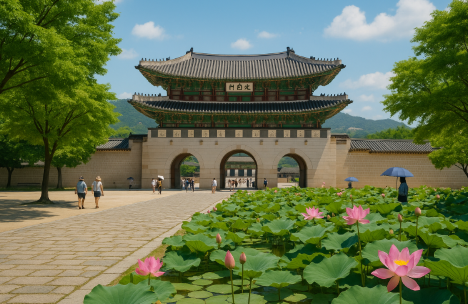Discovering Korean Interior Design: Balancing Tradition and Modernity
Exploring the world of Korean interior design opens a window into a unique blend of ancient tradition and contemporary style. South Korea, with its rapid modernization, has successfully maintained elements of its rich cultural heritage while embracing innovative design. This blend creates living spaces that are both functional and aesthetically pleasing. From traditional Hanok homes to sleek, minimalist apartments, Korean interior design is a fascinating field to explore for anyone interested in home aesthetics and cultural heritage.
Traditional Hanok Homes
Hanok, the traditional Korean house, is built with natural materials and designed to harmonize with the surrounding environment. These homes often feature wooden beams, tiled roofs, and pagoda-inspired architecture. Hanok buildings are known for their use of ondas, or underfloor heating, which is ideal for Korea’s cold winters. The placement of rooms and use of natural lighting are carefully considered to ensure both aesthetic balance and practical use. Owners of Hanok homes often preserve the original structure while incorporating modern elements to enhance comfort and functionality. This blending of old and new styles is a hallmark of Korean interior design.
Modern Korean Apartments
Modern Korean apartments exude sleek minimalism, often characterized by open spaces and neutral color palettes. The design focuses on maximizing space in urban apartments where square footage can be limited. Pale colors, built-in storage units, and multi-functional furniture are staples in these homes. The influence of technology is significant, with smart home systems being common. These elements make daily living more convenient by integrating lighting, temperature control, and security systems into one cohesive unit. Despite the modern influence, many apartments also include traditional Korean elements like sliding doors and patterned screens, creating a unique fusion of styles.
Fusion of Styles
Korean interior design frequently finds inspiration from various global influences and seamlessly integrates them. Scandinavian minimalism, Japanese simplicity, and industrial aesthetics often merge with traditional Korean elements, like bamboo flooring or ornate paper screens. These blends of styles cater to varying tastes and provide endless customization possibilities for homeowners. The flexibility of this approach makes it popular among the younger generation seeking modernity without losing touch with traditional aesthetics, ultimately enriching the overall design landscape.
Sustainable Design Practices
Korea’s commitment to sustainability is increasingly reflected in its interior design practices. Many homeowners are mindful of their ecological footprint, choosing sustainable materials like bamboo or recycled woods. Energy-efficient appliances and LED lighting are common features, contributing to lower energy consumption and reduced environmental impact. The emphasis on sustainability aligns with global trends and showcases Korea’s dedication to preserving the environment while creating beautiful spaces. This responsible approach extends beyond just the materials, influencing the overall philosophy of how space should be used and respected.
Designing for Well-being
In addition to aesthetics, Korean interior design prioritizes psychological comfort and well-being. Elements like natural light, indoor plants, and open spaces enhance mental clarity and relaxation. The interior layouts often encourage movement and functionality, contributing to a holistic approach to living environments. This is reminiscent of the traditional Korean emphasis on harmony between human life and nature. Families value spaces that promote a sense of peace and calm, leading to thoughtful designs that cater to emotional and physical well-being.
Comparison of Interior Design Elements
| Element | Traditional Hanok | Modern Apartments | Fusion Style |
|---|---|---|---|
| Materials | Wood, Clay, Paper | Concrete, Steel, Glass | Bamboo, Recycled Wood |
| Color Palette | Natural Earth Tones | Neutral, Pale Colors | Mix of Warm and Cool |
| Technology | Minimal Use | Smart Home Systems | Moderate Integration |
| Aesthetic Focus | Harmony with Nature | Functionality and Simplicity | Eclectic and Personalized |
FAQ
1. What makes Korean interior design unique?
Korean interior design uniquely combines traditional elements with modern aesthetics, creating spaces that are both functional and culturally rich.
2. Can I incorporate Korean design elements in a non-Korean home?
Yes, elements like ondas, natural materials, and minimalist decor can easily be incorporated into any home, offering a blend of style and comfort.
3. Is Korean interior design sustainable?
Many aspects of Korean design practice sustainability, such as the use of eco-friendly materials and energy-efficient systems, making it a good choice for environmentally conscious homeowners.
Summary
✅ Korean interior design blends tradition and modernity.
✅ Hanok homes use natural materials and reflect traditional values.
✅ Modern apartments embrace minimalism with smart technologies.
✅ Fusion styles incorporate global influences for customized living.
✅ Designing with sustainability and well-being in mind is a key focus.
#KoreanInteriorDesign #Hanok #ModernApartments #SustainableLiving #Minimalism #Tradition #Modernization #DesignInspiration #CulturalHeritage #FunctionalSpaces #SmartLiving #GlobalInfluence #EcoFriendly #InteriorDesign #KoreaCulture #WellBeing #SpaceHarmonization #NaturalMaterials #FusionDesign #KoreanHomes #CulturalAesthetics #HeritagePreservation #InteriorTrends #TraditionalDesign #ModernKorea #DesignBalance #UrbanLiving #SmartHome #HomeAesthetics #CulturalFusion

